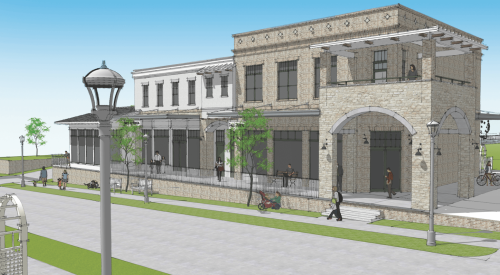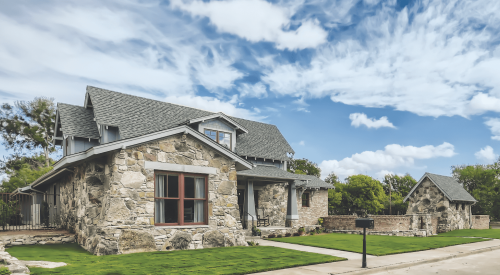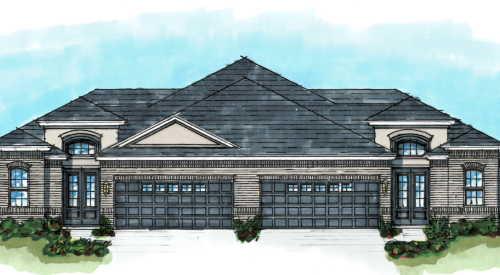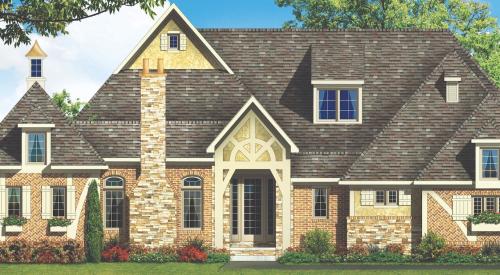| Proportional and detailed, GarnettÆs country French concept for aging boomers is not remotely "cookie cutter.".
|
Noted residential designer Larry Garnett says he is not a masochist, then again he agreed to sift through thousands of pages of transcripts and hours of videotape generated by Professional BuilderÆs series of focus groups with aging baby boomers around the country. His task: take the lifestyle preferences expressed by rooms full of boomers and make them real.
In these pages Garnett presents a concept home he designed for Professional Builder to reflect the needs of this critically important demographic group. Aging boomers want a home that looks great and has enormous flexibility. They intend to remain active for years to come, particularly with career activity. In addition to the need for flexible living spaces, interviews with aging boomers around the country also yielded distinct preferences that Garnett incorporated into this concept home.
Living Space
At 1840 square feet with 265 square feet of bonus space above the garage, the concept house is smaller than homes boomers raised their families in and yet will not feel smaller. A covered porch and well-landscaped outdoor areas are closely connected to the very open inside living space of the home. The kitchen is the center of surrounding activity in the great room with its media center, fireplace and access to the outdoor patio and porch, the dining area, and a general-purpose resource center. Indoor views of the outside areas are important. Garnett calls views of the patio and back areas of the home from the kitchen "tremendous."
Nine-foot ceilings throughout the home feel spacious and yet diverge from the two-story foyers and great rooms typical of the recent past. With a one-story floor plan, the intended effect of eliminating volume ceilings has less to do with adding more space on the second floor than it does to maintain a degree of coziness often lost in airy great rooms.
| Built-ins near the entry (below) and elsewhere in the home add feeling and function to a floor plan designed with plenty of flex space and a relationship with private outdoor spaces created by well landscaped front and side yards.
|
Privacy for guests is even greater. They walk a few steps under a covered porch to a guest studio that is attached to, but separate from, the two-car garage and the bonus room above it. It is a form of the casitas that have been an important element in California design for many years, says Garnett.
In the master suite, aging boomer preferences are prevalent. A standard-sized tub could be upgraded to a jetted bath but not enlarged. The extra space is transferred to a larger shower room with a built-in seat. Cleverly, the master bath is adjacent to a laundry room off the hallway leading to the other two bedrooms. An opening in the wall provides a pass through for dirty laundry directly from the area where it is generated.
The flexible space theme is primarily reflected in two areas of the house: the front bedroom/study located off the entry and bonus space above the garage. The bonus space is whatever someone wants it to be, says Garnett, but he seems to think it would best serve as a play area or teen room for grandchildren. With a pitched ceiling, the bonus room is well lighted by a window facing the front yard as well as by a window facing the side yard off the stairway. The upshot: it, too, can be used as an everyday office. Another use is simply that of finished storage space for things the house wonÆt hold but the owner is not prepared to part with.
Garnett points out that the room off the front entry could be a strong asset for someone whose home-based business requires face-to-face meetings. Guests would barely have to enter the house for business meetings.
Built Ins and Other Touches
With costs (excluding land) of about $80 per square foot, Larry GarnettÆs concept house is rich with built-ins and detail elements. The entry, for example, includes an art glass windowed nook that brightens a spot for mail, keys, purses, newspapers and the like to be set and stored. "It is a place to hide and organize all that. Everyone has a separate little cubby hole and drawer," says Garnett.
| Elevations of built-ins designed by Garnett for a space new to most homes: the resource center. Just off the great room/kitchen, the name says it all. Two people can work comfortably in this designated catch-all workplace.
|
| When possible, place natural light sources as close as possible to work surfaces and other critical areas.
|
Great Curb Appeal
A repeated theme throughout PBÆs conversations with aging boomers was the desire for unique front elevations. GarnettÆs concept home hit this target squarely. Residential designers working in the New Urbanist environment have an easier time providing this uniqueness, aided by site plans that call for alleys and rear garages. Because most communities are not alley-loaded, Garnett felt the need to keep the garage out front. He eliminated the snout effect by turning it 90 degrees and further hid the garage doors under an elongated roofline that forms a covered walkway area. The effect is an unbroken feel of country French style along its 65-foot wide front.
"We tried to come up with something that would fit on a typical developed lot," says Garnett. "Secondly, I paid attention to scale and proportion and details. You donÆt see 16 gables on the front of the house like you see so often these days."
Details make the difference. Shutters look as is if they could actually close and cover arched and ample windows. The fatade is an old-world mix of stone and brick. The roof line does change, but is nonetheless clean. Landscaping is crucial. In front, it provides a buffer between the front facing bedrooms and the motor court. Out back, trees and shrubs also create privacy.
"As the lots get smaller because of cost, there is often very little privacy to the back of your house," notes Garnett. "Some of these side courtyard areas made possible with creative landscaping are very appealing. Landscaping is an integral part of a design such as this."












